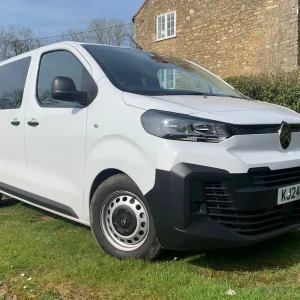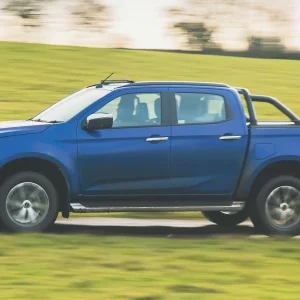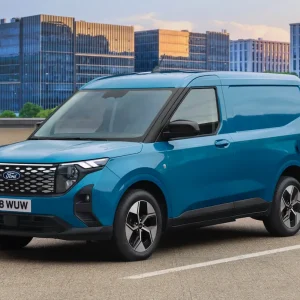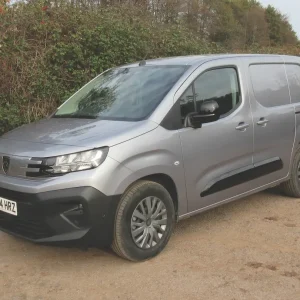Do you want to be noticed? Really noticed? Drive the front-wheel drive Formula Edition of Renault’s Master and there is little doubt you will be.
That is certainly what we found when we took to the highway in what we began to refer to as the ‘Dark Destroyer’, although as representatives of a responsible publication we, of course, took care not to destroy anything…
Channelling the French manufacturer’s involvement in Formula One, the 3.5-tonner is finished in pearlescent black paint with black alloy wheels. Formula Edition decals grace its sides, and yellow highlights around the front fog lights, under the black front grille with its black Renault diamond, and on the wheels help it stand out in the high street. It certainly is in marked contrast to the majority of Masters, which look nowhere near as exciting.
Available with rear-wheel drive too, the Master is powered by a 2.3-litre dCi diesel at 110hp, 130hp, 145hp, 165hp or 170hp. An electric version is on its way.
With four lengths and three roof heights, van load cubes range from 8.0m3 to 17.0m3, gross weights run from 2.8t to 4.5t, while gross payloads extend from 898kg to 2,158kg.
The Master is also produced as a crew van, a chassis cab, a chassis double-cab, a platform cab, a six- or nine-seater Combi and as a 17-seater minibus. A variety of special conversions have been introduced including dropsides, tippers, box vans and Lutons.

Load bay
Our demonstrator came with an optional loading pack that includes an offside sliding door and gives the twin rear doors the ability to swing through 270° and be latched against the van’s sides.
A resin-coated plywood floor cover is included in the deal.
The offside door complements the standard nearside sliding door.
All three door apertures are wide and high, making for ease of loading, and there’s a 12V power point on the offside rear door pillar.
A full-height steel bulkhead ensures that nothing slides forward and finishes up in the cab, although with our demonstrator there would be no excuse for failing to lash cargo down. For an extra charge it came with no less than 16 tie-down points instead of the usual eight, including three on each side of the rear aperture and six set into the floor.
A shelf above the cab, accessible solely from the cargo area – timbered-out on our test vehicle – can be used to store load lashing straps.
Front-wheel drive means a low loading height, and an optional rear step made it easier to climb in and out of the cargo bay, which boasts two lights.

Interior and equipment
Anybody who climbs behind the wheel of this three-seater Master will find that they are blessed with a quite extraordinary amount of storage space. There is a shelf or a bin wherever you look.
There are three bins in each of the doors, and the largest one in each case has a moulding that can play host to a flask or a big bottle of water.
Glance up and you’ll see shelves above the windscreen on both the driver and the passenger sides. A slot between them that can accommodate a tachograph can play host to your sunglasses if one is not fitted.
A deep, lidded but not lockable glove box is provided and you will find another lidded compartment on top of the dashboard, along with a variety of trays and a holder for small change for parking meters.
Twin cupholders project from close to the bottom of the dashboard, along with a shelf below them. Both arrangements steal leg space from the middle passenger.
You’ll find a cupholder and a cubbyhole at each extremity of the fascia. A pull-out shelf pops up vertically from the middle of the dashboard with a clip that keeps paperwork in place.
Pull up the passenger seat cushions and you will find a big hidden compartment – just the place to conceal easily stolen power tools. Flip the back of the middle seat down and it turns into a desk with two cupholders and a section that swivels towards the driver to make it easier to use.
Complete with lumbar adjustment and an inboard armrest, the driver’s seat is height-adjustable, as is the leather-trimmed steering wheel. Electric windows and electrically adjustable and heated exterior mirrors are fitted with lower wide-angle sections.
The Formula Edition’s cab is graced by what Renault describes as a Luxe pack. It includes chrome door handles and dial surrounds among other decorative flourishes.
Our demonstrator came with an optional R-Link multimedia system that embraces TomTom Live navigation plus a 7in overhead touchscreen.
Also provided are a FM/AM/DAB radio tuner, a CD player, Bluetooth connectivity, voice control and USB and aux-in sockets.
The radio can be controlled using buttons on the dash or on the steering column, as well as from the screen.
The screen will also tell you what is behind when you engage reverse if the optional reversing camera fitted. Rear parking sensors are standard and can be deactivated.
Air-conditioning is fitted along with cruise control and a 12V power point. Now with a plastic plug, what was once the socket for the cigarette lighter gives you another 12V power source.
Onboard safety systems include ABS, electronic brakeforce distribution, electronic stability control and hill-start assist. Also provided are Grip Xtend and Trailer Swing Assist. The former is an added-traction device that should help you make progress on loose surfaces. Working with the electronic stability control system, the latter helps bring a trailer under control if it starts to get a bit twitchy.
Disc brakes are fitted all round and the driver is protected by an airbag. No airbag for the passengers, though.
One of the cleverest safety measures we have ever seen in any van is the blind-spot mirror. Mounted on the inside of the passenger sun visor, it allows you to spot cyclists who may be inching up your inside when you are about to make a left-hand turn.
Continuing with the topic of safety, our demonstrator was equipped with an optional safety pack that includes a lane departure warning system. It alerts you if you start daydreaming and wander into the adjoining lane. The pack also dips the headlights automatically at night in the face of oncoming traffic.

Engine and gearbox
Maximum power kicks in at 3,500rpm while top torque of 380Nm bites at 1,500rpm. The four-cylinder 16-valve twin-turbo engine is married to a standard six-speed manual gearbox – a Quickshift6 automated ’box is available as an option on the Master – and our demonstrator was fitted with stop/start to help keep fuel usage down.
It can be switched off if needs be.
AdBlue is required to enable the dCi engine to meet Euro6 standards and is held in a 22-litre tank. The filler point is concealed behind a flap next to the driver’s door.
Driving
MacPherson struts helped support our test vehicle’s front end, with single-leaf springs installed at the back. Its 16in wheels were fitted with 225/65 R16 C ContiVanContact 200 tyres from Continental.
Power-assisted steering offers a 13.6m turning circle between kerbs, rising to 14.1m between walls.
With strong acceleration all the way up through the gears accompanied by a muted whistle from the turbochargers, this Master isn’t minded to hang about. It packs a lot of punch and we suspect that anybody who sees it bearing down on them in their rear-view mirror will be inclined to get out of the way.
A smooth gear change enables the driver to get the best of what all those 170 horses have to offer, and they don’t create all that much noise when they are at the gallop. In-cab noise levels are reasonably well suppressed.
While the handling is by no means as sharp as that of the Fiat Professional Ducato we tested (in the August issue), it is acceptable for a van of its size. It’s a shame the ride isn’t smoother, however.
Fuel economy? We averaged approximately 36.0mpg, which is a little short of the official combined figure.
Pressing the Eco button on the dashboard cuts fuel usage by up to 10%, says Renault, without any noticeable loss of performance, which is true when you’re heading down the motorway lightly laden, although you may want to forget Eco when tackling a few steep hills with a bit of weight onboard.
That is because switching to it alters the engine’s torque settings.
Our test van was fitted with a 105-litre long-range fuel tank rather than the 80-litre tank usually installed.
Renault’s build quality is improving. The materials employed appear to be of a higher standard than they used to be and the heavy doors all shut with a satisfying clunk.
Renault has, of course, been working closely with Mercedes-Benz in recent years, with the latter’s Citan a close cousin to the former’s Kangoo. Maybe Merc’s approach to quality is having an effect elsewhere in the Renault range.

Buying and running
The Master Formula Edition is protected by a three-year/100,000-mile warranty with no mileage restriction during the first two years.
The deal includes three years’ roadside assistance, a three-year paintwork warranty and a six-year anti-perforation corrosion warranty.
Service intervals are set at two years/25,000 miles.
The LED daytime running lights should last forever and it’s good to see a full-size spare wheel. Good, too, to see that the metallic paint – which some observers have suggested is closer to brown than black – is protected by side rubbing strips.
Renault Master Van MM35 dCi 170hp Formula Edition
Price (ex VAT) £33,150
Price range (ex VAT) £25,120-£36,220
Gross payload 1,529kg
Load volume 10.8m3
Load length 3,083mm
Load width (min/max) 1,380/1,765mm
Load bay height 1,894mm
Loading height 548mm
Rear door aperture 1,580×1,820mm
Side door aperture 1,270mmx1,780mm
Gross vehicle weight 3,500kg
Braked trailer towing weight 2,500kg
Residual value 15.0%*
Cost per mile 65.7p*
Engine size/power 2,298cc, 170hp @ 3,500rpm
Torque 380Nm @ 1,500rpm
Gearbox 6-spd
Fuel economy 39.2mpg (combined)
Fuel tank 105 litres
CO2 186g/km
Warranty 3yrs/100,000mls
Service intervals 2yrs/25,000mls
Insurance group 48
Price as tested £36,130
* After 4yrs/80,000mls; source: KwikCarcost
Options fitted
Loading pack £800
R-Link multimedia system £675
Safety pack £500
Rear step £350
Reversing camera £350
Cornering lights £130
105-litre fuel tank £100
Extra load tie-down points £75
Rivals
Ford Transit
Price (ex VAT) £24,470-£36,285
Load volume 9.5-15.1m3
Gross payload 872-2,169kg
Engines 105hp, 130hp, 170hp 2.0 diesel
Verdict: The Ford Transit remains extraordinarily successful, a success that is underpinned by impressive engines, a smooth gear change and a sensibly designed cab interior. You should think about opting for the SelectShift six-speed automatic gearbox if you’re on home-delivery work.
Mercedes-Benz Sprinter
Price (ex VAT) £24,350-£44,275
Load volume 7.8-17.0m3
Gross payload 804-2,547kg
Engines 112hp, 140hp, 163hp 2.1 diesel, 190hp 3.0 diesel
Verdict: Recently revised extensively, the Sprinter now comes with the choice of either front- or rear-wheel drive – 4×4 models are produced too – and its optional nine-speed auto ’box is astonishingly capable. Safety is given top billing with a variety of onboard systems available to lessen the risk of accidents.
Peugeot Boxer
Price (ex VAT) £22,335-£31,795
Load volume 8.0-17.0m3
Gross payload 11,15-1,900kg
Engines 109hp, 131hp, 161hp 2.0 diesel
Verdict: Viewed in the past as a bit of an also-ran, the Boxer is in reality an attractive package that in Professional trim delivers almost all buyers are likely to want. It is also marketed by sister brand Citroen under the Relay banner and by Fiat as the Ducato, although the latter takes different engines.
The Final Verdict
|
Design |
7/10 |
Stand-out looks yet remains a practical cargo carrier. |
|
Cabin |
8/10 |
Few offer more storage in what is a comfortable environment. |
|
Ride |
6/10 |
Room for improvement, especially when lightly laden. |
|
Refinement |
8/10 |
One of the best put-together Renaults we’ve ever come across. |
|
Load area |
8/10 |
Easy access, plenty of load tie-down points, low cargo bed. |
|
Handling/performance |
7/10 |
Former is so-so, the latter is exemplary across the rev band. |
|
Engine/transmission |
8/10 |
A well-matched combination delivering ample performance. |
|
Standard equipment |
7/10 |
Most of what you require is there. |
|
Operating costs |
7/10 |
Decent warranty and service interval should help limit costs§. |
|
What Van? subjective rating |
7/10 |
Should spark interest in more conventional Masters. |






